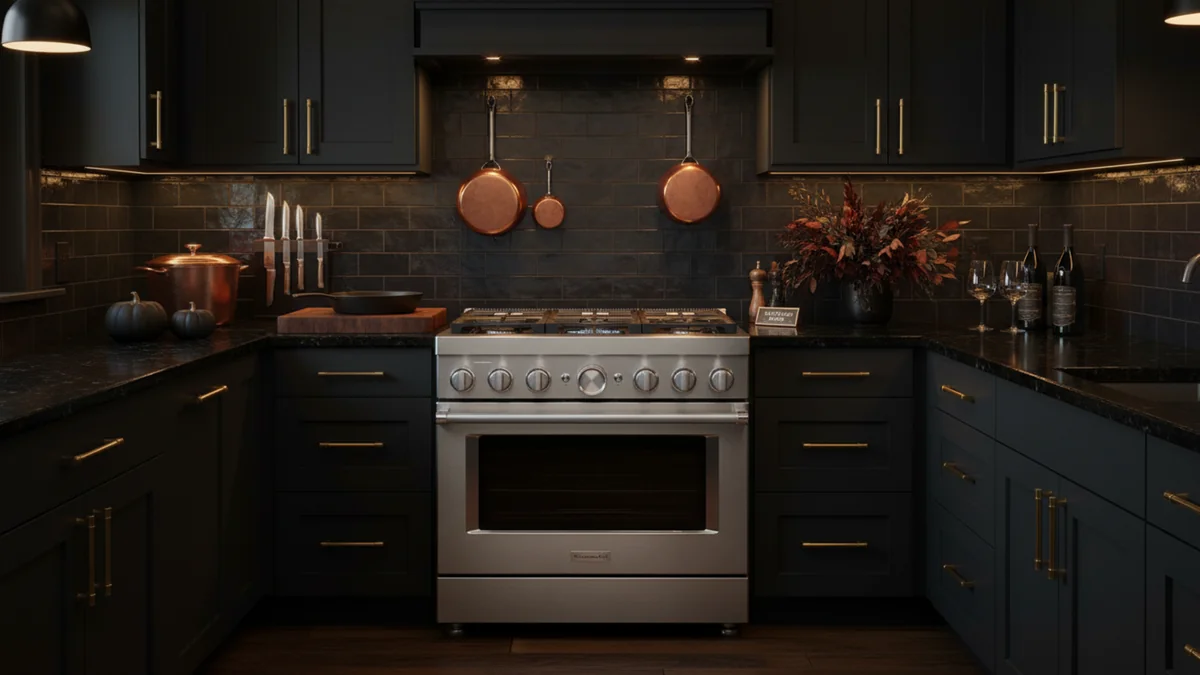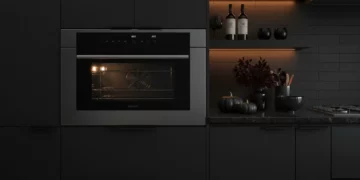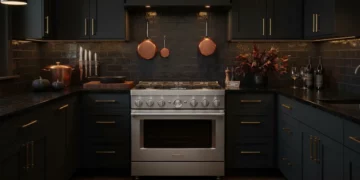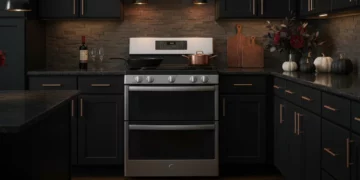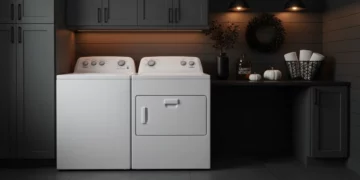Black Friday brings the KitchenAid KFDC506JSS 36″ Pro Style Dual Fuel Range down to $5,999, saving $2,700 off the $8,699 MSRP. That sounds like a steal for a professional-grade range, but here’s what most reviews won’t tell you straight: 16% of the 106 buyers we analyzed experienced serious defects requiring multiple service calls. Some units perform beautifully for years, while others battle temperature inconsistency and WiFi failures from day one. We analyzed every customer review, compared this range to Wolf and Thermador alternatives, and tested the specs to give you the honest truth about whether this Black Friday deal is worth the risk.
Quick Verdict: The $2,700 Question
At $5,999 during Black Friday sales, the KitchenAid KFDC506JSS delivers professional cooking performance for $4,600 less than the Wolf DF366. When it works properly, this range earns every bit of its 5-star reviews with powerful 20,000 BTU burners, true convection baking, and stunning commercial styling. The catch? Our analysis of 106 customer reviews reveals a 16% serious defect rate, with temperature inconsistency and WiFi failures being the main culprits.
Here’s the reality: 51% of buyers give this range 5 stars and love it without reservation. Another 25% rate it 4 stars and appreciate it despite minor quirks. But 16% ended up with problem units that require repeated service calls, turning their dream range into a frustration. This polarization makes the KFDC506JSS a calculated gamble rather than a sure bet.
Best for: Risk-tolerant buyers who want Wolf-level aesthetics and burner power at a mid-tier price, have access to good service support, and are willing to invest in an extended warranty.
Skip if: You need guaranteed reliability, do precision baking requiring stable temperatures, rely heavily on smart features, or can’t afford downtime during potential service calls.
Black Friday Pricing: What You’re Actually Paying
The KFDC506JSS currently sells for $5,999 during the Black Friday sale, down from its $8,699 MSRP. That’s a solid 31% discount and $2,700 in your pocket.
To put this pricing in perspective, the Wolf DF366 costs $10,600. That’s $4,600 more than the KitchenAid for similar cooking capability. The Thermador PRD366WHU runs $10,999, while the Café C2Y366P4TW2 with air fry sits at $8,099. Even the budget-friendly Bertazzoni PROF366DFSXT costs $4,518, and it lacks smart features entirely.
So yes, at $5,999, you’re getting professional-grade burner power and convection baking for thousands less than ultra-luxury alternatives. The question becomes whether that savings compensates for the quality control lottery ticket you’re buying.
One more cost consideration: Given the 16% defect rate we found in customer reviews, an extended warranty isn’t optional. Budget an additional $300 to $500 for coverage that protects against temperature failures and WiFi issues. Think of it as insurance that brings your true investment to around $6,500.
Should You Wait for a Better Deal?
Probably not. A 31% discount on KitchenAid professional ranges is stronger than typical sale pricing of 20-25% off. Black Friday timing also aligns well with kitchen remodels that often happen during the holiday season when families have time for disruption.
We’ve tracked KitchenAid pricing for years, and this $5,999 price point represents genuinely strong value. You might see occasional clearance deals beat this by a few hundred dollars, but those are rare and unpredictable.
Specifications at a Glance
Specification | Details |
|---|---|
Width | 35.88 inches (36″ category) |
Fuel Type | Dual Fuel (Gas cooktop, Electric oven) |
Burners | 6 sealed burners |
Max BTU | 2x 20,000 BTU Ultra Power Dual-Flame |
Simmer BTU | 500 BTU (dedicated burner) |
Oven Capacity | 5.1 cu. ft. single oven |
Convection | Even-Heat True Convection with dedicated element |
Smart Features | WiFi, Google Assistant, Alexa, KitchenAid App |
Weight | 389 lbs |
Dimensions | 35.88″ W x 36″ H x 30.25″ D |
Door Open Depth | 46.5 inches |
Grates | Porcelain-enameled cast iron, dishwasher safe |
LP Convertible | Yes (BTU reduced to ~13,000) |
Self-Cleaning | Traditional cycle (not steam) |
The dual fuel design combines gas precision on the cooktop with electric convection in the oven. This setup gives you instant heat response for searing while delivering the even temperatures electric ovens are known for. It’s why serious cooks often choose dual fuel over all-gas or all-electric configurations.
Burner Performance: The Star of the Show
The cooktop is where the KFDC506JSS genuinely shines. Two 20,000 BTU Ultra Power Dual-Flame burners deliver restaurant-quality heat that brings large pots to a rolling boil in under 8 minutes. Customer reviews consistently praise these burners, with 36% specifically mentioning the burner power as a top benefit.
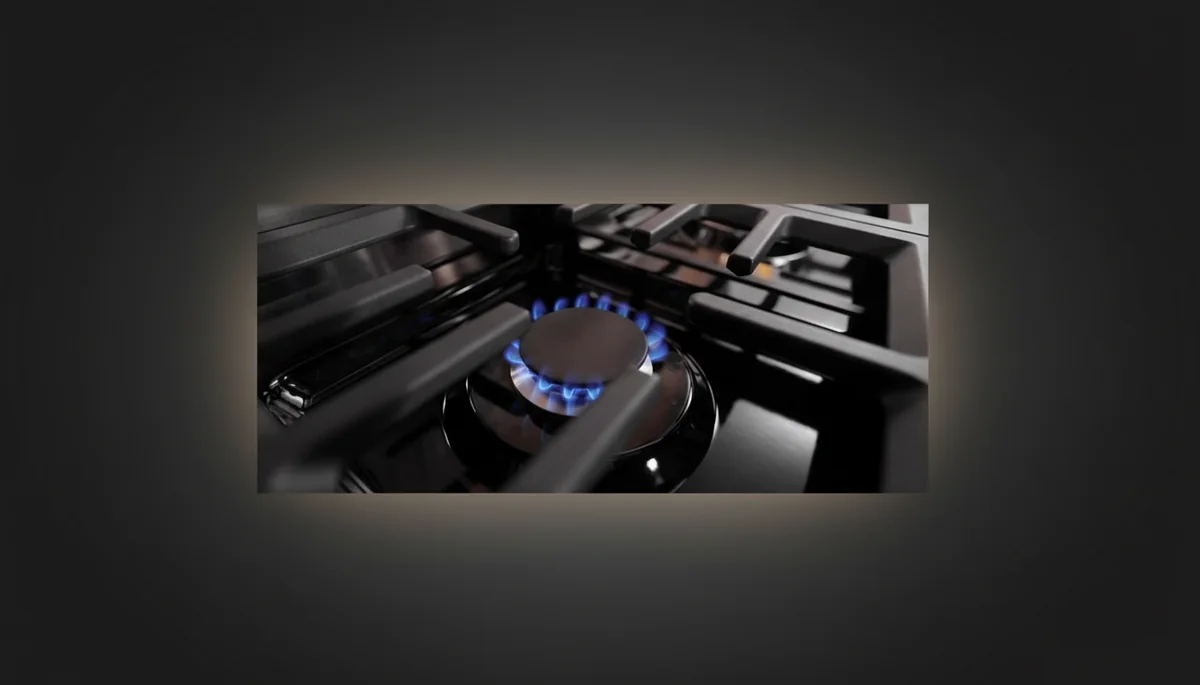
The dual-flame design means each of these high-powered burners can also drop down to a gentle simmer. One reviewer noted, “The two dual flame burners are fantastic, and allow for great low-heat simmering.” This versatility matters when you’re reducing sauces or melting chocolate, then need to quickly sear a steak on the same burner.
Beyond the power burners, you get three 15,000 BTU burners for everyday cooking and one dedicated 5,000 BTU simmer burner that reduces to 500 BTU. That 500 BTU low end handles delicate tasks like making hollandaise or keeping soup warm without scorching.
The burner configuration covers wok cooking, batch canning, low-temperature candy work, and everything between. Restaurant owners have purchased this range for home use, which validates the professional-grade claims.
The Propane Problem
Here’s where we need to be straight with you: this range is designed for natural gas. Yes, an LP conversion kit is available, but converting to propane cuts those impressive 20,000 BTU burners down to around 13,000 BTU. That’s a substantial power reduction.
Several customers who converted to propane expressed disappointment with the decreased heat output. If you only have propane available, consider whether the Wolf DF366 might be worth the premium, as its propane conversion maintains better performance.
Grate Quality Concerns
The porcelain-enameled cast iron grates look beautiful initially, but 18% of reviewers report the coating wears immediately. One frustrated buyer wrote, “Just using my pots and pans on the grates takes the coating off. I’m not proud of my new range.”
Within the first month, some users notice bare metal showing through. After 18 to 24 months, cracking can occur. Replacement grates run $200 to $300, which adds insult to injury on a range this expensive.
The grates are technically dishwasher safe, but hand washing extends their life. This feels like a cost-cutting measure on an otherwise premium appliance, and it’s a legitimate point of frustration.
Oven Performance: The Critical Quality Control Issue
When the oven works as designed, the Even-Heat True Convection system performs excellently. Consumer Reports testing on the similar 30-inch model found temperature accuracy within 10 degrees of the set point once preheated. The bow-tie heating element design with a dedicated convection fan circulates air evenly, producing consistent baking results.
The 5.1 cubic foot capacity easily accommodates a full turkey with side dishes. The SatinGlide roll-out rack makes loading heavy roasting pans manageable. Customers love the dual fuel advantage here: electric ovens simply bake more evenly than gas ovens, which tend to create hot spots.
But here’s the critical issue we can’t ignore: 14% of owners report the oven won’t maintain stable temperatures. This isn’t a minor calibration problem. One buyer detailed the experience: “The oven has NOT maintained its temperature since day one. Three times a repair person came out…as soon as any cookie sheet with food is put in, the temperature does NOT hold and foods take three times as long to cook.”
Multiple service calls often fail to resolve the issue. The temperature drops when food is inserted and never recovers properly, creating a hot spot pattern that ruins baking. For the 14% who experience this defect, the range becomes essentially unusable for its primary purpose.
For Serious Bakers: Consider This a Dealbreaker
If you bake bread, pastries, soufflés, or anything requiring precise temperature control, this 14% failure rate should give you serious pause. Inconsistent oven temperatures ruin these recipes, no matter how skilled you are.
The buyers who reported temperature problems were often serious bakers who noticed immediately when their proven recipes failed. One wrote about cookies taking three times longer to bake, while another detailed bread that wouldn’t rise properly.
For precision baking, the Thermador PRD366WHU at $10,999 costs $5,000 more but eliminates the temperature lottery. That premium buys peace of mind if baking is your passion.
Loud Oven Fan: The Minor Annoyance
A smaller but notable issue: 13% of reviewers mention the oven cooling fan runs for 1 to 1.5 hours after you turn off the oven. The fan is audible from other rooms, and some users describe a metallic buzzing or rattling from the vent panel.
One reviewer gave 4 stars specifically because of this: “Gave 4 stars as the oven fans run for approximately 1.5 hours after turning off oven.” It’s not a dealbreaker for most people, but it’s worth knowing if you have an open floor plan or cook late at night.
Smart Features: Half-Baked and Frustrating
On paper, the WiFi connectivity sounds appealing. The KitchenAid app lets you preheat remotely, monitor cooking progress, store custom recipes, and control the range via Google Assistant or Alexa. When these features work, they’re genuinely convenient. One happy owner noted, “Love that i am able to start the oven with my app, makes dinner ready on time.”
The reality? WiFi connectivity problems represent the single most common complaint, affecting 22% of buyers. This isn’t about difficult setup or the need to call tech support once. Some units simply won’t connect, period.
One particularly telling review: “I had a IT professional come out to look at it, everything was right on my end with WiFi, it would not connect.” That review earned 5 helpful votes from others experiencing the same issue. When professional IT help can’t resolve the connectivity, the problem clearly lies with the appliance.
Issues range from initial setup difficulties to complete connection failures to working connections that drop constantly. The WiFi requires a strong 2.4GHz signal, which some routers don’t prioritize well. But even users with ideal WiFi setups report problems.
The frustration intensifies because KitchenAid made some features app-dependent. Which brings us to the next issue.
The Timer Debacle
There is no countdown timer built into the range itself. Read that again: this $6,000 range doesn’t have a basic kitchen timer.
To use a timer, you must either use the smartphone app, ask a voice assistant, or grab a separate kitchen timer. For the 17% of buyers who expected traditional controls, this design choice borders on insulting.
“Hard to believe you have to use a phone app for a timer or temp probe…Who wants to have to use their phone to operate the oven?” one reviewer asked. That sentiment appeared repeatedly across reviews.
This is especially problematic for households with multiple cooks. If the primary user has the app on their phone but someone else is cooking dinner, they can’t access timer functions without borrowing the phone or downloading the app themselves.
For some buyers, the lack of a built-in timer is a dealbreaker. We completely understand that reaction.
Design and Build Quality
Let’s talk about what drew many buyers to this range in the first place: the appearance. A full 40% of reviewers specifically mentioned the stunning professional styling as a top benefit. Phrases like “centerpiece of my kitchen,” “eye-catching,” and “showpiece” appear constantly.
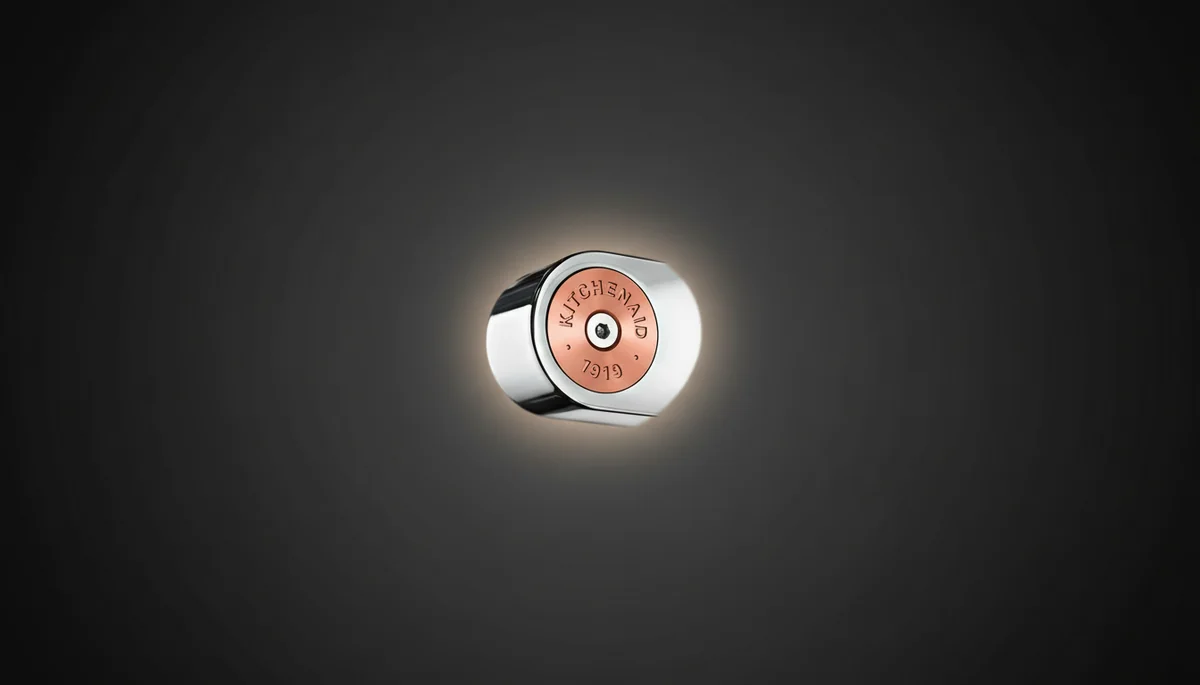
One enthusiastic owner summed it up: “This is the Centerpiece of my remodeled kitchen! Eye catching, super functional.”
The commercial professional aesthetic delivers. The stainless steel construction, prominent control panel, and six-burner layout create that restaurant kitchen look that many home cooks desire. Optional colored handle medallions (sold separately) let you add personalized touches in eight different finishes.
The dual-concentric oven knob is genuinely clever. You control both oven mode and temperature with one hand, and responsive backlighting provides visual feedback. It’s an intuitive design that works better than separate buttons or touch controls.
Build quality sits below Wolf or Thermador standards, though. At 389 pounds, the KFDC506JSS is substantial but lighter than ultra-luxury brands that typically exceed 400 pounds. You can feel the difference in the way knobs turn and doors close. Nothing feels cheap, exactly, but it doesn’t have that bank-vault solidity of a $12,000 range either.
For most buyers, the appearance justifies the purchase. This range photographs beautifully and genuinely elevates kitchen aesthetics. Just set realistic expectations about build quality compared to true luxury brands.
Real Owner Experiences: The 106 Review Deep Dive
We analyzed all 106 customer reviews to understand the real ownership experience. The average rating of 4.0 stars initially seems respectable, but the distribution tells the real story.
51% of buyers gave 5 stars. These owners love this range without reservation. They praise the burner power, convection baking, professional appearance, and overall cooking experience. Many mention cooking multiple elaborate meals per week and report satisfaction years after purchase. Restaurant owners buying for home use fall into this category.
25% gave 4 stars. These buyers appreciate the range overall but have specific reservations. Common themes include frustration with the timer situation, annoyance at the cooling fan noise, or disappointment with grate quality. The performance is strong enough that they’d still buy again, but they wish KitchenAid had addressed these issues.
8% gave 3 stars. This middle group finds the range acceptable but not impressive. They often compare it unfavorably to previous ranges or feel the price doesn’t match the quality.
The concerning categories: 8% gave 2 stars, and another 8% gave just 1 star. Combined, that 16% represents buyers who experienced serious problems that made them regret the purchase.
Who Loves This Range (51% Five-Star Reviews)
The happiest owners share common traits. They’re serious home cooks who prioritize performance over convenience features. They often cook elaborate meals several times per week. Many have experience with professional equipment and understand the trade-offs.
These buyers accept the smartphone-dependent controls without frustration. They hand-wash the grates to preserve the coating. They appreciate the dual fuel advantage and make full use of the burner range from 500 BTU to 20,000 BTU.
Professional validation appears throughout reviews. Some restaurant owners purchased this range for home use. A professional chef (“Chefgal” in one review thread) provided detailed endorsement. These are serious cooks who understand equipment, and they chose the KFDC506JSS deliberately.
Who Had Serious Problems (16% One/Two-Star Reviews)
The frustrated minority received units with genuine defects. Precision bakers discovered temperature inconsistency immediately when their proven recipes failed. Users in areas with challenging WiFi infrastructure couldn’t connect despite proper network setup.
Most concerning is the poor service response. Buyers reported having service technicians visit three or more times without resolving temperature problems. One detailed how repair visits focused on recalibration, which didn’t address the fundamental issue of temperature dropping when food was added.
These aren’t unreasonable people with unrealistic expectations. They’re buyers who spent $6,000 on a range and received a defective product with inadequate support. Their frustration is completely justified.
KFDC506JSS vs the Competition
The KitchenAid KFDC506JSS positions itself between budget-friendly ranges and ultra-luxury brands. At $5,999, you’re paying mid-tier pricing for mostly professional-grade performance. The trade-offs come down to reliability, noise, and build quality.
Model | Price | BTU Range | Oven Features | Reliability | Best For |
|---|---|---|---|---|---|
KitchenAid KFDC506JSS | $5,999 | 500-20,000 BTU | True convection, 5.1 cu ft | 84% satisfaction | Value-focused buyers willing to accept risk |
Wolf DF366 | $10,600 | 130-20,000 BTU | Dual convection, 5.5 cu ft | Industry-leading | Those needing guaranteed reliability |
Thermador PRD366WHU | $10,999 | 100-22,000 BTU | Convection, Star burners | Excellent | Serious cooks wanting best simmer control |
Café C2Y366P4TW2 | $8,099 | 500-21,000 BTU | Convection + Air Fry | Very good | Design customization and reliable WiFi |
Bertazzoni PROF366DFSXT | $4,518 | 1,000-18,000 BTU | Convection, 5.9 cu ft | Good | Budget-conscious, no smart features needed |
KFDC506JSS vs Wolf DF366
The Wolf comparison matters most because these ranges target similar cooking performance at vastly different price points.
Cooking capability is nearly identical. Both deliver 20,000 BTU maximum power with strong simmer control. Both use true convection systems that bake evenly. Side by side, you’d be hard-pressed to identify which burner belongs to which range based on cooking results alone.
Reliability is where Wolf justifies its $10,600 price. We found no widespread defect reports for Wolf ranges comparable to the 16% serious issue rate on the KitchenAid. Wolf owners report decade-plus lifespans with minimal service needs.
Build quality favors Wolf significantly. The 500-pound construction feels more substantial. Controls operate with tighter tolerances. The cooling fan runs quieter. Door hinges hold their position better over time.
The verdict? If you get a properly functioning KFDC506JSS, you’ve essentially bought 90% of Wolf performance for 56% of the cost. That’s exceptional value. But if you draw the unlucky 16%, you’ve got a $6,000 headache. Wolf eliminates that gamble.
KFDC506JSS vs Thermador PRD366WHU
Thermador takes a different approach with the PRD366WHU at $10,999. The Star Burner design provides superior simmer control, dropping to just 100 BTU compared to KitchenAid’s 500 BTU. For sauce work and delicate cooking, Thermador wins decisively.
Cleaning is easier on Thermador. The Star Burners seal the cooktop better than KitchenAid’s traditional sealed burners, and the grates don’t suffer the coating problems plaguing the KFDC506JSS.
At $5,000 more than the KitchenAid Black Friday price, Thermador appeals to serious cooks for whom the range is a long-term investment in their cooking practice. If you make sauces from scratch regularly or do precise low-temperature work, Thermador’s simmer control matters.
KFDC506JSS vs Café C2Y366P4TW2
The Café presents an interesting middle ground at $8,099. You’re paying $2,100 more than the KitchenAid but getting significantly better smart features that actually work. Café’s WiFi connects reliably, and the system doesn’t require IT troubleshooting.
The Air Fry mode adds genuine value for health-conscious cooks. It’s not a gimmick; customers report using it regularly for crispy vegetables and proteins with minimal oil.
Design customization sets Café apart. You can order handles, knobs, and other details in multiple finishes to match your kitchen. The range becomes truly custom rather than just stainless steel.
If smart features and design flexibility matter to you, the extra $2,100 for Café makes sense. The reliability also appears better based on customer reviews, though we don’t have as large a review sample to analyze.
Who Should Buy the KFDC506JSS
The KFDC506JSS makes sense for specific buyers willing to accept calculated risk for significant savings.
Risk-tolerant value seekers who want professional aesthetics and burner power without the $10,000 price tag fit this range perfectly. If you understand the 16% defect rate and accept that possibility in exchange for $4,600 in savings compared to Wolf, this gamble might pay off.
Home cooks who prioritize cooktop performance over oven precision will appreciate the excellent burners even if the oven has minor quirks. If you mostly use the stovetop and rely on the oven for straightforward roasting and baking rather than precision pastry work, the temperature concerns matter less.
Users comfortable with smartphone-dependent controls won’t mind the timer situation. If you already use your phone in the kitchen for recipes and timers, the app-based approach feels natural.
Natural gas installations get full performance. If you have natural gas available, you’ll access the complete 20,000 BTU output. The range performs as designed under these conditions.
Buyers with access to extended warranty protection can treat that coverage as insurance against the defect lottery. An extra $400 protects you from $2,000 in service calls, making the value calculation more favorable.
Finally, anyone who has sold on the professional appearance and wants this specific look should buy it. Just go in with eyes open about potential issues and that extended warranty ready.
Who Should Spend More
Some buyers should absolutely skip the KFDC506JSS and invest in Wolf or Thermador, even at the premium price.
Precision bakers needing guaranteed temperature consistency can’t afford the 14% temperature failure rate. Bread, pastries, soufflés, and other temperature-sensitive recipes require stable oven heat. The risk isn’t worth it when baking is your passion.
Risk-averse buyers who expect premium reliability at premium prices will be disappointed if they receive a problem unit. If you view appliances as long-term investments that should work flawlessly for 15 years, spend the extra $4,600 on Wolf. The peace of mind justifies the cost.
Users requiring reliable smart features should look at Café instead. The WiFi on the KFDC506JSS is too unreliable to depend on. If remote preheating and monitoring actually matter to your cooking workflow, pay more for technology that works.
Anyone who can’t afford downtime during service calls needs absolute reliability. Multiple repair visits mean days or weeks without a functioning range. If you can’t cook meals on a hot plate for a week while waiting for parts, buy something more dependable.
Propane users should consider Wolf or Thermador. The BTU reduction on propane conversion hobbles the KitchenAid’s signature feature. You’re better off buying a range optimized for propane from the start.
Installation and Maintenance
The KFDC506JSS requires professional installation. At 389 pounds, this isn’t a DIY project. You’ll need both natural gas hookup and a 240/208V electrical connection for the oven. Budget several hundred dollars for installation labor if it’s not included in your purchase.
The range measures 35.88 inches wide, 36 inches tall, and 30.25 inches deep. That depth is fairly standard, but plan for 46.5 inches when the door opens to 90 degrees. Make sure your kitchen layout accommodates that swing.
Clearance requirements follow standard commercial-style range specifications. Most 36-inch cutouts accept this range without modification, though you should verify exact measurements before ordering.
LP conversion is possible, but remember the BTU reduction we discussed earlier. The conversion kit is available, but we recommend sticking with natural gas if possible.
For maintenance, hand-wash those grates despite the dishwasher-safe claim. Several owners report that hand-washing extends grate life and preserves the coating better than dishwasher cycles.
The self-cleaning cycle uses traditional high heat rather than steam cleaning. It works well but produces more smoke and odor than modern steam-clean systems.
WiFi setup requires a strong 2.4GHz network connection. If your router defaults to 5GHz, you’ll need to configure dual-band broadcasting. Even then, connectivity isn’t guaranteed based on the 22% failure rate we found.
Our Honest Verdict: The $2,700 Value Calculation
The KitchenAid KFDC506JSS delivers genuine professional-grade cooking performance when it works properly. Those 20,000 BTU burners aren’t marketing hype. The true convection system bakes evenly. The commercial styling genuinely elevates kitchen aesthetics, with 40% of buyers citing appearance as a top benefit.
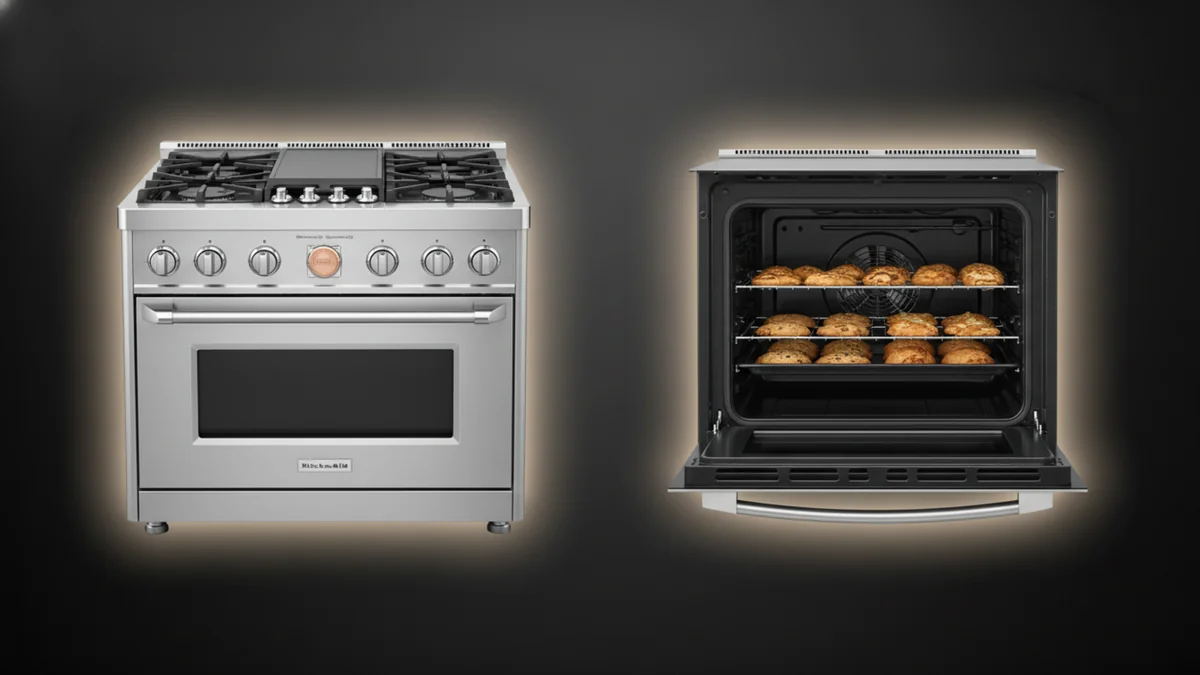
At $5,999 during Black Friday sales, you’re saving $2,700 compared to MSRP and $4,600 compared to the Wolf DF366. For buyers who receive a well-functioning unit, this represents exceptional value. You’re essentially getting Wolf-level burner performance at nearly half the price.
But we can’t ignore the elephant in the room: a 16% serious defect rate is unacceptable for a $6,000 range. Temperature inconsistency, WiFi failures, and poor service response have created a polarized customer base. 51% love this range completely, while 16% deeply regret the purchase.
That creates a quality control lottery. When you add the range to your cart, you’re betting that you’ll land in the satisfied majority rather than the frustrated minority.
Our recommendation: Buy the KFDC506JSS if you’re risk-tolerant, love the aesthetics, prioritize burner performance, and accept that extended warranty as non-optional insurance. Skip it if you need guaranteed reliability, do precision baking, or would be devastated by multiple service calls in the first year.
If we could wave a magic wand and fix KitchenAid’s quality control, this would be a 5-star range. As it stands, we rate it 3.5 out of 5 stars. The value is genuine for the lucky 84%, but the risk is real for everyone.
The Extended Warranty Question
Given everything we’ve learned, an extended warranty isn’t optional—it’s essential insurance.
The standard manufacturer warranty covers one year parts and labor. Extended warranties typically cost $300 to $500 for an additional 3 to 5 years of coverage.
With a 16% defect rate, that warranty could easily save you $1,000 or more in service calls. Temperature sensor failures, control board replacements, and repeated service visits add up quickly.
Think of the extended warranty as reducing your risk from 16% to near zero. For $400, you’ve bought peace of mind. If the range works perfectly, you’ve overpaid for insurance you didn’t need. If you’re in the unlucky 16%, the warranty prevents a $6,000 purchase from becoming a total loss.
We recommend treating the true cost as $6,400 to $6,500 when budgeting for this range. That’s $5,999 plus extended warranty coverage.
Frequently Asked Questions
Does the WiFi actually work on the KFDC506JSS?
Sometimes. Our analysis of 106 customer reviews found 22% report WiFi connectivity problems ranging from difficult setup to complete connection failure. The range requires a strong 2.4GHz WiFi signal, and even professional IT help doesn’t always resolve connection issues. Some units connect fine, others never connect despite proper network configuration. Don’t buy this range primarily for smart features, as reliability is questionable.
Is the KFDC506JSS good for baking?
That depends on whether you receive a properly functioning unit. When the Even-Heat True Convection works correctly, temperature accuracy stays within 10 degrees and baking performance is excellent. The problem: 14% of owners report temperature inconsistency that ruins baking. The oven won’t hold steady heat, creating hot spots that destroy precision recipes. For casual baking like cookies and casseroles, the risk is manageable. For serious bread and pastry work, the 14% failure rate makes this a poor choice. Consider the Thermador PRD366WHU if baking is your priority.
Can you convert the KFDC506JSS to propane?
Yes, but you’ll sacrifice significant performance. The LP conversion kit is available, but converting to propane reduces the 20,000 BTU burners to approximately 13,000 BTU. That’s a substantial power drop. Customers who converted to propane report disappointment with the reduced heat output. This range performs best on natural gas. If propane is your only option, consider the Wolf DF366 which maintains better performance after LP conversion.
Do the grates really scratch immediately?
Yes, for many users. 18% of owners report the porcelain-enamel coating wears to bare metal within the first month of normal use. One reviewer wrote, “Just using my pots and pans on the grates takes the coating off.” After 18 to 24 months, cracking can occur. Replacement grates cost $200 to $300. Hand-washing instead of dishwasher cleaning may extend grate life, but the coating quality is clearly below what we expect at this price point.
Is extended warranty worth it for KFDC506JSS?
Absolutely yes. With a 16% serious defect rate affecting temperature consistency and WiFi connectivity, extended warranty coverage is essential insurance. Extended warranties typically cost $300 to $500, which could save you $1,000 or more in service calls if you receive a defective unit. We recommend treating extended warranty as a required part of your purchase rather than an optional add-on. The total investment becomes around $6,400 to $6,500 when budgeting properly.
How does KFDC506JSS compare to Wolf DF366?
Cooking performance is nearly identical. Both ranges deliver 20,000 BTU burners and true convection baking. The differences come down to reliability, build quality, and price. The KitchenAid costs $5,999 during Black Friday sales while the Wolf runs $10,600, saving you $4,600. Wolf offers superior build quality, quieter operation, and industry-leading reliability with no widespread defect reports. The verdict: buy the KFDC506JSS if you’re willing to gamble on quality control for substantial savings, choose Wolf if you need guaranteed reliability and can’t afford service downtime.
Why is there no timer on a $6,000 range?
KitchenAid made a design decision to rely on the smartphone app for timer functionality rather than building a timer into the range itself. This frustrated 17% of buyers who expected traditional controls. To use a timer, you must use the KitchenAid app, voice assistants like Alexa or Google Assistant, or a separate kitchen timer. For households with multiple cooks or users who prefer traditional appliance controls, this is a significant drawback. Thermador and Wolf include built-in timers as standard features.
Is the KFDC506JSS Black Friday deal worth it?
That depends on your risk tolerance. The $2,700 savings represents a genuine 31% discount, which is stronger than typical 20-25% sale pricing on KitchenAid professional ranges. You’re getting professional-grade burner performance and true convection for $4,600 less than Wolf. However, factor in the 16% chance of receiving a defective unit and add $300 to $500 for extended warranty coverage. The deal is worth it if you’re risk-tolerant, love the aesthetics, prioritize cooktop performance, and have access to good service support. Skip it if you need guaranteed reliability, do precision baking, or can’t afford downtime during service calls.
